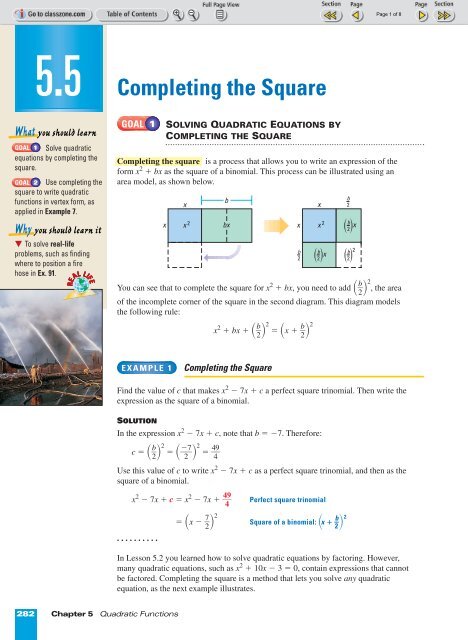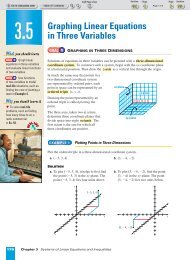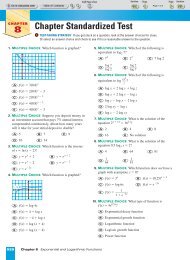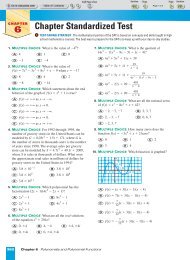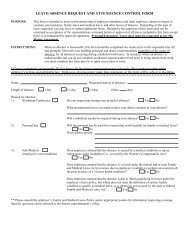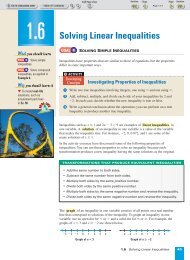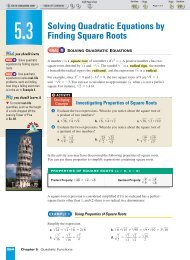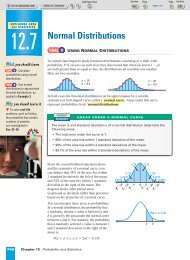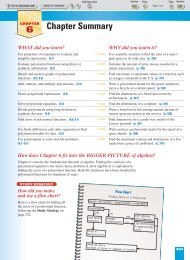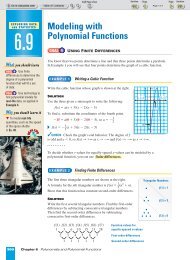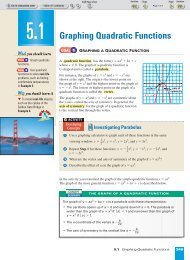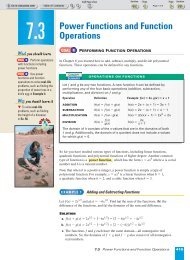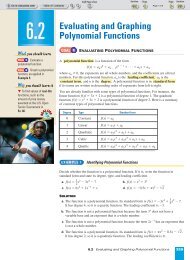Alg. 2 Chapter 5.5 - Beau Chene High School Home Page
Alg. 2 Chapter 5.5 - Beau Chene High School Home Page
Alg. 2 Chapter 5.5 - Beau Chene High School Home Page
You also want an ePaper? Increase the reach of your titles
YUMPU automatically turns print PDFs into web optimized ePapers that Google loves.
<strong>5.5</strong><br />
Completing the Square<br />
What you should learn<br />
GOAL 1 Solve quadratic<br />
equations by completing the<br />
square.<br />
GOAL 2 Use completing the<br />
square to write quadratic<br />
functions in vertex form, as<br />
applied in Example 7.<br />
Why you should learn it<br />
To solve real-life<br />
problems, such as finding<br />
where to position a fire<br />
hose in Ex. 91.<br />
REAL<br />
LIFE<br />
GOAL 1<br />
SOLVING QUADRATIC EQUATIONS BY<br />
COMPLETING THE SQUARE<br />
Completing the square is a process that allows you to write an expression of the<br />
form x 2 + bx as the square of a binomial. This process can be illustrated using an<br />
area model, as shown below.<br />
x<br />
b<br />
x x 2<br />
bx<br />
x x 2<br />
You can see that to complete the square for x 2 + bx, you need to add b 2 2 , the area<br />
of the incomplete corner of the square in the second diagram. This diagram models<br />
the following rule:<br />
b<br />
2<br />
x 2 + bx + b 2 2 = x + b 2 2<br />
x<br />
b<br />
2<br />
b<br />
2<br />
( )x<br />
b<br />
( 2 ( )x b<br />
2 )2<br />
EXAMPLE 1<br />
Completing the Square<br />
Find the value of c that makes x 2 º 7x + c a perfect square trinomial. Then write the<br />
expression as the square of a binomial.<br />
SOLUTION<br />
In the expression x 2 º7x + c, note that b = º7. Therefore:<br />
c = b 2 2 = º 7<br />
2<br />
2 = 4 9 <br />
4<br />
Use this value of c to write x 2 º 7x + c as a perfect square trinomial, and then as the<br />
square of a binomial.<br />
x 2 º7x + c = x 2 º7x + 4 49 Perfect square trinomial<br />
. . . . . . . . . .<br />
= x º 7 2 2 Square of a binomial: x + } b 2 } 2<br />
In Lesson 5.2 you learned how to solve quadratic equations by factoring. However,<br />
many quadratic equations, such as x 2 + 10x º 3 = 0, contain expressions that cannot<br />
be factored. Completing the square is a method that lets you solve any quadratic<br />
equation, as the next example illustrates.<br />
282 <strong>Chapter</strong> 5 Quadratic Functions
EXAMPLE 2<br />
Solving a Quadratic Equation if the Coefficient of x 2 Is 1<br />
Solve x 2 + 10x º 3 = 0 by completing the square.<br />
STUDENT HELP<br />
Study Tip<br />
In Example 2 note that<br />
you must add 25 to both<br />
sides of the equation<br />
x 2 + 10x = 3 when<br />
completing the square.<br />
SOLUTION<br />
x 2 + 10x º 3 = 0<br />
Write original equation.<br />
x 2 +10x = 3<br />
Write the left side in the form x 2 + bx.<br />
x 2 +10x + 5 2 = 3 + 25 Add } 1 0<br />
2<br />
} 2 = 5 2 = 25 to each side.<br />
(x +5) 2 = 28 Write the left side as a binomial squared.<br />
x + 5 = ±28<br />
Take square roots of each side.<br />
x = º5 ± 28 Solve for x.<br />
x = º5 ± 27<br />
Simplify.<br />
The solutions are º5 + 27 and º5 º 27.<br />
✓CHECK You can check the solutions by<br />
substituting them back into the original<br />
equation. Alternatively, you can graph<br />
y = x 2 +10x º 3 and observe that the<br />
x-intercepts are about 0.29 ≈ º5 + 27<br />
and º10.29 ≈ º5 º 27.<br />
. . . . . . . . . .<br />
Zero<br />
X=-10.2915 Y=0<br />
If the coefficient of x 2 in a quadratic equation is not 1, you should divide each side of<br />
the equation by this coefficient before completing the square.<br />
EXAMPLE 3<br />
Solving a Quadratic Equation if the Coefficient of x 2 Is Not 1<br />
Solve 3x 2 º6x + 12 = 0 by completing the square.<br />
SOLUTION<br />
3x 2 º6x + 12 = 0<br />
Write original equation.<br />
x 2 º2x + 4 = 0 Divide each side by the coefficient of x 2 .<br />
x 2 º2x = º4<br />
Write the left side in the form x 2 + bx.<br />
x 2 º2x + (º1) 2 = º4 + 1 Add } º 2<br />
2<br />
} 2 = (º1) 2 = 1 to each side.<br />
(x º1) 2 = º3 Write the left side as a binomial squared.<br />
x º 1 = ±º3<br />
x = 1 ± º3 Solve for x.<br />
Take square roots of each side.<br />
x = 1 ± i 3 Write in terms of the imaginary unit i.<br />
The solutions are 1 + i 3 and 1 º i 3.<br />
✓CHECK Because the solutions are imaginary, you cannot check them graphically.<br />
However, you can check the solutions algebraically by substituting them back into<br />
the original equation.<br />
<strong>5.5</strong> Completing the Square 283
REAL<br />
LIFE<br />
EXAMPLE 4<br />
Using a Quadratic Equation to Model Distance<br />
Traffic Engineering<br />
On dry asphalt the distance d (in feet) needed for a car to stop is given by<br />
d = 0.05s 2 +1.1s<br />
where s is the car’s speed (in miles per hour). What speed limit should be posted on a<br />
road where drivers round a corner and have 80 feet to come to a stop?<br />
SOLUTION<br />
d = 0.05s 2 +1.1s<br />
Write original equation.<br />
80 = 0.05s 2 +1.1s Substitute 80 for d.<br />
1600 = s 2 +22s Divide each side by the coefficient of s 2 .<br />
1600 + 121 = s 2 +22s + 11 2 Add } 2 2<br />
2<br />
} 2 = 11 2 = 121 to each side.<br />
1721 = (s + 11) 2 Write the right side as a binomial squared.<br />
±1721 = s +11<br />
º11 ± 1721 = s Solve for s.<br />
Take square roots of each side.<br />
s Š30 or s ż52 Use a calculator.<br />
Reject the solution º52 because a car’s speed cannot be negative. The posted<br />
speed limit should be at most 30 miles per hour.<br />
REAL<br />
LIFE<br />
EXAMPLE 5<br />
Using a Quadratic Equation to Model Area<br />
Landscape Design<br />
You want to plant a rectangular garden along part of a 40 foot side of your house. To<br />
keep out animals, you will enclose the garden with wire mesh along its three open<br />
sides. You will also cover the garden with mulch. If you have 50 feet of mesh and<br />
enough mulch to cover 100 square feet, what should the garden’s dimensions be?<br />
x<br />
x<br />
house<br />
garden<br />
50 – 2x<br />
SOLUTION<br />
Draw a diagram. Let x be the length of the sides of the garden perpendicular to the<br />
house. Then 50 º 2x is the length of the third fenced side of the garden.<br />
x(50 º 2x) = 100 Length ª Width = Area<br />
50x º2x 2 = 100<br />
Distributive property<br />
º2x 2 +50x = 100 Write the x 2 -term first.<br />
40 ft<br />
x 2 º25x = º50 Divide each side by º2.<br />
x 2 º25x + (º12.5) 2 = º50 + 156.25<br />
Complete the square.<br />
(x º 12.5) 2 = 106.25 Write as a binomial squared.<br />
x º 12.5 = ±106.25<br />
x = 12.5 ± 106.25 Solve for x.<br />
x ≈ 22.8 or x ≈2.2<br />
Take square roots of each side.<br />
Use a calculator.<br />
Reject x = 2.2 since 50 º 2x = 45.6 is greater than the house’s length. If<br />
x = 22.8, then 50 º 2x = 4.4. The garden should be about 22.8 feet by 4.4 feet.<br />
284 <strong>Chapter</strong> 5 Quadratic Functions
GOAL 2<br />
WRITING QUADRATIC FUNCTIONS IN VERTEX FORM<br />
Given a quadratic function in standard form, y = ax 2 + bx + c, you can use<br />
completing the square to write the function in vertex form, y = a(x º h) 2 + k.<br />
EXAMPLE 6<br />
Writing a Quadratic Function in Vertex Form<br />
STUDENT HELP<br />
HOMEWORK HELP<br />
Visit our Web site<br />
www.mcdougallittell.com<br />
for extra examples.<br />
INTERNET<br />
Write the quadratic function y = x 2 º8x + 11 in vertex form. What is the vertex of<br />
the function’s graph?<br />
SOLUTION<br />
y = x 2 º8x +11<br />
Write original function.<br />
y + ? = (x 2 º8x + ? ) + 11 Prepare to complete the square for x 2 º 8x.<br />
y + 16 = (x 2 º8x + 16)+11<br />
y +16= (x º4) 2 +11<br />
º8<br />
} 2<br />
Add 2 = (º4) 2 = 16 to each side.<br />
Write x 2 º 8x + 16 as a binomial squared.<br />
y = (x º4) 2 º5 Solve for y.<br />
The vertex form of the function is y = (x º4) 2 º 5. The vertex is (4, º5).<br />
REAL<br />
LIFE<br />
EXAMPLE 7<br />
Finding the Maximum Value of a Quadratic Function<br />
Agriculture<br />
The amount s (in pounds per acre) of sugar produced from sugarbeets can be<br />
modeled by the function<br />
s = º0.0655n 2 + 7.855n + 5562<br />
where n is the amount (in pounds per acre) of nitrogen fertilizer used. How much<br />
fertilizer should you use to maximize sugar production? What is the maximum<br />
amount of sugar you can produce?<br />
Source: Sugarbeet Research and Education Board of Minnesota and North Dakota<br />
SOLUTION<br />
The optimal amount of fertilizer and the maximum amount of sugar are the<br />
coordinates of the vertex of the function’s graph. One way to find the vertex is<br />
to write the function in vertex form.<br />
s = º0.0655n 2 + 7.855n + 5562<br />
s = º0.0655(n 2 º 120n) + 5562<br />
s º 0.0655( ? ) = º0.0655(n 2 º 120n + ? ) + 5562<br />
s º 0.0655(3600) = º0.0655(n 2 º 120n + 3600) + 5562<br />
s º 236 = º0.0655(n º 60) 2 + 5562<br />
s = º0.0655(n º 60) 2 + 5798<br />
The vertex is approximately (60, 5798). To maximize sugar production, you<br />
should use about 60 pounds per acre of nitrogen fertilizer. The maximum amount<br />
of sugar you can produce is about 5800 pounds per acre.<br />
<strong>5.5</strong> Completing the Square 285
GUIDED PRACTICE<br />
Vocabulary Check ✓<br />
Concept Check ✓<br />
Skill Check ✓<br />
1. Describe what it means to “complete the square” for an expression of the form<br />
x 2 + bx.<br />
2. Which method for solving quadratic<br />
equations—factoring or completing the<br />
square—is more general? Explain.<br />
3. ERROR ANALYSIS A student tried to write<br />
y = ºx 2 º6x + 4 in vertex form as shown.<br />
Explain the student’s mistake. Then write the<br />
correct vertex form of the function.<br />
Find the value of c that makes the expression a perfect square trinomial. Then<br />
write the expression as the square of a binomial.<br />
4. x 2 +2x + c 5. x 2 +14x + c 6. x 2 º6x + c<br />
7. x 2 º10x + c 8. x 2 +5x + c 9. x 2 º13x + c<br />
Solve the equation by completing the square.<br />
y =ºx 2 º 6x + 4<br />
y =º(x 2 + 6x) + 4<br />
y + 9 =º(x 2 + 6x + 9) + 4<br />
y + 9 =º(x + 3) 2 + 4<br />
y =º(x + 3) 2 º 5<br />
10. x 2 +4x =º1 11. x 2 º2x =4 12. x 2 º16x +76=0<br />
13. x 2 +8x +9=0 14. 2x 2 +12x =4 15. 3x 2 º12x + 93 = 0<br />
Write the quadratic function in vertex form and identify the vertex.<br />
16. y = x 2 +12x 17. y = x 2 º4x +7 18. y = x 2 º8x +31<br />
19. y = x 2 +10x +17 20. y =ºx 2 +14x º45 21. y =2x 2 +4x º4<br />
22. LANDSCAPE DESIGN Suppose the homeowner in Example 5 has 60 feet<br />
of wire mesh to put around the garden and enough mulch to cover an area of<br />
140 square feet. What should the dimensions of the garden be?<br />
PRACTICE AND APPLICATIONS<br />
STUDENT HELP<br />
Extra Practice<br />
to help you master<br />
skills is on p. 946.<br />
REWRITING EXPRESSIONS Write the expression as the square of a binomial.<br />
23. x 2 +16x +64 24. x 2 +20x + 100 25. x 2 º24x + 144<br />
26. x 2 º38x + 361 27. x 2 + x +0.25 28. x 2 º1.4x +0.49<br />
29. x 2 º3x + 9 4 30. x2 + 1 6 x + 1<br />
144 31. x2 º 4 9 x + 4<br />
81 <br />
COMPLETING THE SQUARE Find the value of c that makes the expression a<br />
perfect square trinomial. Then write the expression as the square of a binomial.<br />
32. x 2 º12x + c 33. x 2 +18x + c 34. x 2 +26x + c<br />
35. x 2 º44x + c 36. x 2 +9x + c 37. x 2 º11x + c<br />
38. x 2 º23x + c 39. x 2 +15x + c 40. x 2 º0.2x + c<br />
41. x 2 º5.8x + c 42. x 2 +1.6x + c 43. x 2 +9.4x + c<br />
44. x 2 º 2 7 x + c 45. x2 + 1 0 x + c 46. x<br />
3<br />
2 + 1 7 x + c<br />
8<br />
286 <strong>Chapter</strong> 5 Quadratic Functions
STUDENT HELP<br />
HOMEWORK HELP<br />
Example 1: Exs. 23–46<br />
Example 2: Exs. 47–54,<br />
63–64<br />
Example 3: Exs. 55–72<br />
Example 4: Exs. 89–91<br />
Example 5: Exs. 92, 93<br />
Example 6: Exs. 73–84<br />
Example 7: Exs. 94, 95<br />
COEFFICIENT OF X 2 IS 1 Solve the equation by completing the square.<br />
47. x 2 +2x =9 48. x 2 º12x =º28<br />
49. x 2 +20x + 104 = 0 50. x 2 +3x º1=0<br />
51. u 2 º4u =2u +35 52. v 2 º17v + 200 = 13v º43<br />
53. m 2 +1.8m º1.5=0 54. n 2 º 4 3 n º 1 =0<br />
94<br />
COEFFICIENT OF X 2 IS NOT 1 Solve the equation by completing the square.<br />
55. 2x 2 º12x =º14 56. º3x 2 +24x =27<br />
57. 6x 2 +84x + 300 = 0 58. 4x 2 +40x + 280 = 0<br />
59. º4r 2 +21r = r +13 60. 3s 2 º26s +2=5s 2 +1<br />
61. 0.4t 2 +0.7t =0.3t º0.2 62. w º w 24 2 + 1 =0<br />
63<br />
2<br />
SOLVING BY ANY METHOD Solve the equation by factoring, by finding<br />
square roots, or by completing the square.<br />
63. x 2 +4x º12=0 64. x 2 º6x º15=0<br />
65. 9x 2 º23=0 66. 2x 2 +9x +7=0<br />
67. 3x 2 + x =2x º6 68. 4(x +8) 2 = 144<br />
69. 7k 2 +10k º 100 = 2k 2 +55 70. 14b 2 º19b +4=º11b 2 +11b º5<br />
71. 0.01p 2 º0.22p +2.9=0 72. q º 9 q<br />
=18<br />
4 20<br />
WRITING IN VERTEX FORM Write the quadratic function in vertex form and<br />
identify the vertex.<br />
73. y = x 2 º6x +11 74. y = x 2 º2x º9 75. y = x 2 +16x +14<br />
76. y = x 2 +26x +68 77. y = x 2 º3x º2 78. y = x 2 +7x º1<br />
79. y =ºx 2 +20x º80 80. y =ºx 2 º14x º47 81. y =3x 2 º12x +1<br />
82. y =º2x 2 º2x º7 83. y =1.4x 2 +5.6x +3 84. y = 2 3 x2 º 4 5 x<br />
2<br />
2<br />
STUDENT HELP<br />
Skills Review<br />
For help with areas of<br />
geometric figures,<br />
see p. 914.<br />
GEOMETRY CONNECTION Find the value of x.<br />
85. Area of rectangle = 100 86. Area of triangle = 40<br />
x<br />
x<br />
x 10<br />
x 8<br />
87. Area of trapezoid = 70 88. Area of parallelogram = 54<br />
x<br />
x 4<br />
x 5<br />
3x<br />
x<br />
<strong>5.5</strong> Completing the Square 287
JACKIE JOYNER-<br />
KERSEE became<br />
one of the greatest female<br />
athletes in history despite<br />
having severe asthma as a<br />
child and as an adult. She<br />
has won six Olympic medals:<br />
three gold, one silver, and<br />
two bronze.<br />
REAL<br />
LIFE<br />
FOCUS ON<br />
PEOPLE<br />
89. TRAFFIC ENGINEERING For a road covered with dry, packed snow, the<br />
formula for a car’s stopping distance given in Example 4 becomes:<br />
d =0.08s 2 +1.1s<br />
Show that, in snowy conditions, a driver cannot safely round the corner in<br />
Example 4 when traveling at the calculated speed limit of 30 miles per hour.<br />
What is a safe speed limit if the road is covered with snow?<br />
90. SPORTS Jackie Joyner-Kersee won the women’s heptathlon during the 1992<br />
Olympics in Barcelona, Spain. Her throw in the shot put, one of the seven events<br />
in the heptathlon, can be modeled by<br />
y = º0.0241x 2 + x +<strong>5.5</strong><br />
where x is the shot put’s horizontal distance traveled (in feet) and y is its<br />
corresponding height (in feet). How long was Joyner-Kersee’s throw?<br />
91. FIREFIGHTING In firefighting, a good water stream can be modeled by<br />
y = º0.003x 2 + 0.62x + 3<br />
where x is the water’s horizontal distance traveled (in feet) and y is its<br />
corresponding height (in feet). If a firefighter is aiming a good water stream at<br />
a building’s window 25 feet above the ground, at what two distances can the<br />
firefighter stand from the building?<br />
92. CORRALS You have 240 feet of<br />
wooden fencing to form two adjacent<br />
rectangular corrals as shown. You<br />
want each corral to have an<br />
w<br />
area of 1000 square feet.<br />
a. Show that w =80º 4 L<br />
L<br />
3 ¬. Not drawn to scale<br />
b. Use your answer from part (a) to find the possible dimensions of each corral.<br />
93. POTTERY You are taking a pottery class. As an assignment, you are given<br />
a lump of clay whose volume is 200 cubic centimeters and asked to make a<br />
cylindrical pencil holder. The pencil holder should be 9 centimeters high and<br />
have an inner radius of 3 centimeters. What thickness x should your pencil holder<br />
have if you want to use all the clay? (Hint: The volume of clay equals the<br />
difference of the volumes of two cylinders.)<br />
Pencil holder<br />
Not drawn to scale<br />
Top view<br />
3 cm<br />
x cm<br />
x cm<br />
3 cm x cm<br />
9 cm<br />
x cm<br />
Side view<br />
94. BIOLOGY CONNECTION When a gray kangaroo jumps, its path through the air<br />
can be modeled by<br />
y = º0.0267x 2 +0.8x<br />
where x is the kangaroo’s horizontal distance traveled (in feet) and y is its<br />
corresponding height (in feet). How high can a gray kangaroo jump? How<br />
far can it jump?<br />
288 <strong>Chapter</strong> 5 Quadratic Functions
Test<br />
Preparation<br />
★ Challenge<br />
EXTRA CHALLENGE<br />
www.mcdougallittell.com<br />
95. SCIENCE CONNECTION In a fireplace, the heat loss q (in Btu/ft 3 ) resulting from<br />
hot gases escaping through the chimney can be modeled by<br />
q = º0.00002T 2 + 0.0203T º1.24<br />
where T is the temperature (in degrees Fahrenheit) of the gases. (This model<br />
assumes an indoor temperature of 65°F.) For what gas temperature is heat loss<br />
maximized? What is the maximum heat loss? Source: Workshop Math<br />
96. MULTIPLE CHOICE If x 2 º28x + c is a perfect square trinomial, what is the<br />
value of c?<br />
¡ A º14 ¡ B 28 ¡ C 196 ¡ D 784<br />
97. MULTIPLE CHOICE What are the solutions of x 2 +12x +61=0?<br />
¡ A º1, º11 ¡ B º6 ± 5i ¡ C º6 ± 97 ¡ D º6 ± i 61<br />
98. MULTIPLE CHOICE What is the vertex form of y =2x 2 º8x +3?<br />
¡ A y =2(x º2)2 º5 ¡ B y =2(x º2)2 +3<br />
¡ C y =2(x º4)2 º29 ¡ D y =2(x º4)2 +3<br />
CRITICAL THINKING Exercises 99 and 100 should be done together.<br />
99. Graph the two functions in the same coordinate plane.<br />
a. y = x 2 +2x b. y = x 2 +4x c. y = x 2 º6x<br />
y =(x +1) 2 y =(x +2) 2 y =(x º3) 2<br />
100. Compare the graphs of y = x 2 + bx and y =x + b 2 2 . What happens to the<br />
graph of y = x 2 + bx when you complete the square for x 2 + bx?<br />
MIXED REVIEW<br />
EVALUATING EXPRESSIONS Evaluate b 2 º4ac for the given values of a, b,<br />
and c. (Review 1.2 for 5.6)<br />
101. a =1, b =5, c =2 102. a =3, b =º8, c =7<br />
103. a =º5, b =0, c =2.6 104. a = 11, b =4, c =º1<br />
105. a = 16, b = º24, c =9 106. a = º1.4, b =2, c =º0.5<br />
EQUATIONS OF LINES Write an equation in slope-intercept form of the line<br />
through the given point and having the given slope. (Review 2.4)<br />
107. (3, 1), m =2 108. (2, º4), m =1 109. (º7, 10), m =º5<br />
110. (º8, º8), m =º3 111. (6, 9), m = 1 3 112. (11, º2), m =º 5 <br />
4<br />
SYSTEMS OF LINEAR INEQUALITIES<br />
(Review 3.3)<br />
Graph the system of inequalities.<br />
113. x ≥ 2 114. y >º1 115. x ≥ 0<br />
y ≤ 3 y


